Ripon Cathedral
The Cathedral Church of St Peter and St Wilfrid, commonly known as Ripon Cathedral, and until 1836 known as Ripon Minster, is a cathedral in the North Yorkshire city of Ripon. Founded as a monastery by Scottish monks in the 660s, it was refounded as a Benedictine monastery by St Wilfrid in 672. The church became collegiate in the tenth century, and acted as a mother church within the large Diocese of York for the remainder of the Middle Ages.[2] The present church is the fourth, and was built between the 13th and 16th centuries. In 1836 the church became the cathedral for the Diocese of Ripon.[3] In 2014 the Diocese was incorporated into the new Diocese of Leeds, and the church became one of three co-equal cathedrals of the Bishop of Leeds.
| Ripon Cathedral | |
|---|---|
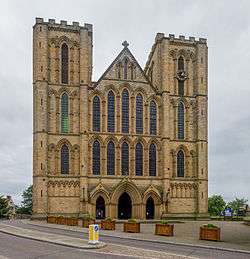 The west front of the cathedral | |
 Ripon Cathedral Shown within North Yorkshire | |
| Location | Ripon, North Yorkshire |
| Country | England |
| Denomination | Church of England |
| Tradition | Anglo-Catholic[1] |
| Website | Official website |
| History | |
| Status | Cathedral (since 1836) |
| Architecture | |
| Functional status | Active |
| Heritage designation | Grade I |
| Style | Anglo-Saxon, Gothic (Early English) |
| Years built | 1160–1547 |
| Administration | |
| Diocese | Leeds (since 2014) |
| Province | York |
| Clergy | |
| Dean | John Dobson |
| Precentor | Michael Gisbourne |
| Canon Chancellor | Barry Pyke (Educator) |
| Canon Pastor | Ailsa Newby |
| Laity | |
| Director of music | Andrew Bryden |
| Organist(s) | Tim Harper |
The cathedral is notable architecturally for its gothic west front in the Early English style, considered one of the best of its type, as well as the Geometric east window.[3] The seventh-century crypt of Wilfrid's church is a significant example of early Christian architecture in England.[3] The cathedral has Grade I listed building status.
Background
There has been a stone church on the site since 672 when Saint Wilfrid replaced the previous timber church of the monastery at Ripon (a daughter house of Saint Aidan's monastery at Melrose) with one in the Roman style. This is one of the earliest stone buildings erected in the Anglo-Saxon Kingdom of Northumbria.[4] The crypt dates from this period.[5]
People have been going to worship and pray at Ripon for more than 1,300 years.[6] The cathedral building is part of this continuing act of worship, begun in the 7th century when Saint Wilfrid built one of England's first stone churches on this site, and still renewed every day. Within the nave and choir, you can see the evidence of 800 years in which master craftsmen have expressed their faith in wood and stone.
History
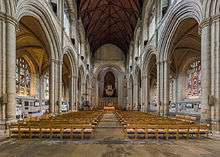
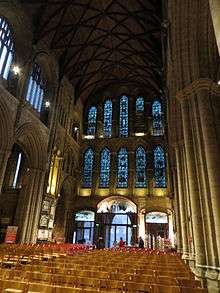
Today's church is the fourth to have stood on this site.[7] Saint Wilfrid brought stonemasons, plasterers and glaziers from France and Italy to build his great basilica in AD 672. A contemporary account by Eddius Stephanus tells us:
In Ripon, Saint Wilfrid built and completed from the foundations to the roof a church of dressed stone, supported by various columns and side-aisles to a great height and many windows, arched vaults and a winding cloister.[8]
Saint Wilfrid was buried in this church near the high altar. Devastated by the English king Eadred in AD 948 as a warning to the Archbishop of York,[9] only the crypt of Wilfrid's church survived but today this tiny 7th-century chapel rests complete beneath the later grandeur of Archbishop Roger de Pont l’Evêque’s 12th century minster.[10] A second minster soon arose at Ripon, but it too perished — this time in 1069 at the hands of William the Conqueror. Thomas of Bayeux, first Norman Archbishop of York, then instigated the construction of a third church, traces of which were incorporated into the later chapter house of Roger's minster.[11]
The Early English west front was added in 1220, its twin towers originally crowned with wooden spires and lead.[12] The east window was built as part of a reconstruction of the choir between 1286-8 and 1330, and was described by architecture critic Pevsner as a 'splendid' example of the series of large Decorated gothic windows constructed in Northern England.[13] Major rebuilding had to be postponed due to the outbreak of the Wars of the Roses but resumed after the accession of Henry VII and the restoration of peace in 1485.[14] The crossing tower was rebuilt after it collapsed in an earthquake in 1450 but was never completed. Between 1501 and 1522 the nave walls were raised higher and the aisles added. The church's thirty-four misericords were carved between 1489 and 1494.[15] The same (Ripon) school of carvers also carved the misericords at Beverley Minster and Manchester Cathedral.[16] But in 1547, before this work was finished, Edward VI dissolved Ripon's college of canons. All revenues were appropriated by the Crown and the tower never received its last perpendicular arches. It was not until 1604 that James I issued his Charter of Restoration.
During the civil war, much of the stained glass was smashed and some of the statues were destroyed.[17][18]
Cathedral status
The minster finally became a cathedral (the church where the Bishop has his cathedra or throne) in 1836, the focal point of the newly created Anglican Diocese of Ripon — the first to be established since the Reformation.[19]
Dean and chapter
As of 2 February 2019:[20]
- Dean — John Dobson (since 14 June 2014 installation)[21]
- Canon Precentor — Michael Gisbourne (since 16 September 2018 installation)[22]
- Canon Educator (i.e. Canon Chancellor) — Barry Pyke (since 11 September 2016 installation;[23] previously called "Canon for Rural Engagement and Education")
- Canon Pastor — Ailsa Newby (since June 2017;[24] Newby is also The Lady Newby by her marriage to Dick Newby)[25]
Music
The current director of music is Andrew Bryden, with Tim Harper as Assistant Director of Music.[26]
Organ
The cathedral has a fine organ by Harrison and Harrison, which is a rebuild of the original Lewis instrument dating from 1878.[27] The organ is on the screen and has casework by Gilbert Scott. A specification of the organ can be found on the National Pipe Organ Register.[28] The organ last underwent a major refurbishment in 2013. These works included a thorough cleaning and repair of all pipe work.[29]
Organists
In 1447, the organ at Ripon Cathedral was played by a priest, Thomas Litster.[30] Notable organists have included composers Charles Harry Moody and Ronald Edward Perrin.
Bells
A ring of 12 bells with an additional 'flat sixth' bell is hung in the south-west tower. A diatonic ring of ten bells was cast in 1932, and three additional bells were installed in 2008 with two new trebles being added to give a diatonic ring of twelve, and an additional 'flat sixth' bell to give a light ring of eight.[31]
Gallery
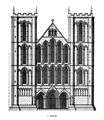 The west front.
The west front.- Detail of the western façade.
%2C_Yorkshire%2C_UK_-_Diliff.jpg) A misericord, alleged inspiration for Lewis Carroll’s Alice's Adventures in Wonderland
A misericord, alleged inspiration for Lewis Carroll’s Alice's Adventures in Wonderland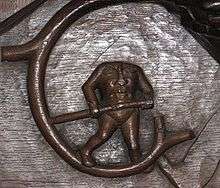 A blemyah carving from a choir stall.
A blemyah carving from a choir stall. Ripon Minster, by Hendrik Frans de Cort, c. 1800.
Ripon Minster, by Hendrik Frans de Cort, c. 1800. Stained glass window St. Michael, West end
Stained glass window St. Michael, West end Moses and Melchisedec, Stained glass window St. Peter's chapel
Moses and Melchisedec, Stained glass window St. Peter's chapel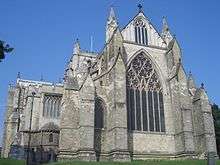 The eastern façade of the cathedral
The eastern façade of the cathedral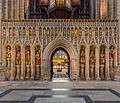 The Rood screen
The Rood screen The Organ
The Organ The Choir of Ripon Cathedral
The Choir of Ripon Cathedral
See also
- Ripon
- Architecture of the medieval cathedrals of England
- English Gothic architecture
- Romanesque architecture
- Church of England
- Diocese of Leeds
- Dean and Chapter of Ripon
- List of Gothic Cathedrals in Europe
References
- Blagdon-Gamlen, P. E. (1973) The Church Travellers Directory. London: Church Literature Association; p. 75
- "History of the Secular and Diocesan Boundaries in Yorkshire" (PDF). Archived (PDF) from the original on 10 March 2016. Retrieved 3 May 2017.
- Pevsner, Nikolaus; Metcalf, Priscilla (2005). The Cathedrals of England: The North and East Anglia. London: The Folio Society. p. 255.
- Wilkinson 1974, p. 3.
- Hallett 1901, p. 75.
- Blow, John (26 November 2019). "Cathedrals report record high visitor numbers in research with York Minster, Ripon, Sheffield, Wakefield and Bradford". The Yorkshire Post. Retrieved 15 July 2020.
- "Ripon Cathedral (Dean and Chapter) Archive - Library | University of Leeds". explore.library.leeds.ac.uk. Retrieved 15 July 2020.
- James, Sara N (2016). "1: Missionaries, monks and marauders: Pre-Conquest England, the heptarchy-Edward the Confessor, C 600–1066". Art in England : the Saxons to the Tudors, 600-1600. Oxford: Oxbow Books. p. 10. ISBN 978-1-78570-223-5.
- Hallett 1901, pp. 10–11.
- Hallett 1901, p. 121.
- Wilkinson 1974, p. 6.
- Wilkinson 1974, p. 10.
- Pevsner, Nikolaus (2009). Leach, Peter; Minnis, John (eds.). Yorkshire West Riding : Leeds, Bradford and the North. New Haven: Yale University Press. pp. 637–658. ISBN 0300126654.
- Wilkinson 1974, p. 19.
- Wilkinson 1974, p. 22.
- Wood, Juanita (1999). Wooden images : misericords and medieval England. London: Associated University Press. p. 25. ISBN 0-8386-3779-5.
- Tate, Lesley (28 March 2019). "Fallen angel prompts £1000,000 restoration work at Ripon Cathedral". Craven Herald. Retrieved 15 July 2020.
- Historic England. "Ripon Minster (Cathedral Church of St Peter and Wilfrid) (1150164)". National Heritage List for England. Retrieved 15 July 2020.
- Hallett 1901, p. 36.
- Ripon Cathedral — Clergy & Staff Archived 24 December 2017 at the Wayback Machine (Accessed 2 February 2019)
- Archived 28 May 2014 at the Wayback Machine
- "New Canon Precentor for Ripon". Archived from the original on 3 February 2019. Retrieved 2 February 2019.
- Ripon Cathedral service sheet, 11 September 2016 Archived 16 January 2018 at the Wayback Machine (Accessed 16 January 2018)
- "Canon Ailsa returns to Northern Roots | Ripon Cathedral". riponcathedral.info. 20 June 2017. Archived from the original on 1 July 2017. Retrieved 20 June 2017.
- Anon (2016). "Newby, Richard Mark". Who's Who. ukwhoswho.com. A & C Black, an imprint of Bloomsbury Publishing plc. doi:10.1093/ww/9780199540884.013.U29365. (subscription or UK public library membership required)
- "The Music Department". Ripon Cathedral. Archived from the original on 6 October 2014. Retrieved 27 October 2014.
- Boeringer, James (1989). Organa britannica : organs in Great Britain 1660-1860 : a complete edition of the Sperling notebooks and drawings in the Library of the Royal College of Organists. London: Bucknell University Press. p. 343. ISBN 0-8387-1894-9.
- "The National Pipe Organ Register - NPOR". www.npor.org.uk. Retrieved 14 July 2020.
- Hersey, Frank (7 February 2014). "Ripon Cathedral celebrates restored organ with a weekend of music". infoweb.newsbank.com. Retrieved 14 July 2020.
- West, John E (1899). Cathedral organists past and present : a record of the succession of organists of the cathedrals, chapels royal, and principal collegiate churches of the United Kingdom, from about the period of the reformation until the present day. / With biographical notes, extracts from the chapter books, anecdotes. London: Novello. p. 70. OCLC 729755533.
- Emma Baxter. "Yorkshire Association of Change Ringers Latest News, Accessed 29 March 2009". Yacr.org.uk. Archived from the original on 27 October 2014. Retrieved 27 October 2014.
Sources
- Hallett, Cecil (1901). The Cathedral church of Ripon; a short history of the church and a description of its fabric. London: G Bell & Sons. OCLC 459726710.CS1 maint: ref=harv (link)
- Wilkinson, W E (1974). Ripon Cathedral. London: Pitkin Pictorials. ISBN 0-85372-117-3.CS1 maint: ref=harv (link)
- "The Dioceses Commission's Yorkshire Review — A Guide to the Report" (PDF). Churchofengland.org. Archived from the original (PDF) on 22 July 2011.
Further reading
- Werronen, Stephen (2017). Religion, Time and Memorial Culture in Late Medieval Ripon. Woodbridge: Boydell & Brewer. ISBN 978-0-86193-345-7.
External links
| Wikimedia Commons has media related to Ripon Cathedral. |